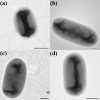Inhibition of Escherichia coli CFT073 fliC expression and motility by cranberry materials
- PMID: 21821749
- PMCID: PMC3187111
- DOI: 10.1128/AEM.05561-11
Inhibition of Escherichia coli CFT073 fliC expression and motility by cranberry materials
Abstract
In humans, uropathogenic Escherichia coli (UPEC) is the most common etiological agent of uncomplicated urinary tract infections (UTIs). Cranberry extracts have been linked to the prevention of UTIs for over a century; however, a mechanistic understanding of the way in which cranberry derivatives prevent bacterial infection is still lacking. In this study, we used a fliC-lux reporter as well as quantitative reverse transcription-PCR to demonstrate that when UPEC strain CFT073 was grown or exposed to dehydrated, crushed cranberries or to purified cranberry-derived proanthocyanidins (cPACs), expression of the flagellin gene (fliC) was inhibited. In agreement with these results, transmission electron microscopy imaging of bacteria grown in the presence of cranberry materials revealed fewer flagella than those in bacteria grown under control conditions. Furthermore, we showed that swimming and swarming motilities were hindered when bacteria were grown in the presence of the cranberry compounds. Because flagellum-mediated motility has been suggested to enable UPEC to disseminate to the upper urinary tract, we propose that inhibition of flagellum-mediated motility might be a key mechanism by which cPACs prevent UTIs. This is the first report to show that cranberry compounds inhibit UPEC motility via downregulation of the fliC gene. Further studies are required to establish whether these inhibitors play a role in vivo.
Figures




Similar articles
-
Pomegranate materials inhibit flagellin gene expression and flagellar-propelled motility of uropathogenic Escherichia coli strain CFT073.FEMS Microbiol Lett. 2012 Sep;334(2):87-94. doi: 10.1111/j.1574-6968.2012.02622.x. Epub 2012 Jul 12. FEMS Microbiol Lett. 2012. PMID: 22708802
-
Propolis potentiates the effect of cranberry (Vaccinium macrocarpon) against the virulence of uropathogenic Escherichia coli.Sci Rep. 2018 Jul 16;8(1):10706. doi: 10.1038/s41598-018-29082-6. Sci Rep. 2018. PMID: 30013052 Free PMC article.
-
Expression of flagella is coincident with uropathogenic Escherichia coli ascension to the upper urinary tract.Proc Natl Acad Sci U S A. 2007 Oct 16;104(42):16669-74. doi: 10.1073/pnas.0607898104. Epub 2007 Oct 9. Proc Natl Acad Sci U S A. 2007. PMID: 17925449 Free PMC article.
-
Cranberry Polyphenols and Prevention against Urinary Tract Infections: Relevant Considerations.Molecules. 2020 Aug 1;25(15):3523. doi: 10.3390/molecules25153523. Molecules. 2020. PMID: 32752183 Free PMC article. Review.
-
Cranberry Consumption Against Urinary Tract Infections: Clinical Stateof- the-Art and Future Perspectives.Curr Pharm Biotechnol. 2018;19(13):1049-1063. doi: 10.2174/1389201020666181206104129. Curr Pharm Biotechnol. 2018. PMID: 30520372 Review.
Cited by
-
Antibacterial activity and mode of action of acetone crude leaf extracts of under-investigated Syzygium and Eugenia (Myrtaceae) species on multidrug resistant porcine diarrhoeagenic Escherichia coli.BMC Vet Res. 2019 May 22;15(1):162. doi: 10.1186/s12917-019-1914-9. BMC Vet Res. 2019. PMID: 31118023 Free PMC article.
-
Cranberry-derived proanthocyanidins prevent formation of Candida albicans biofilms in artificial urine through biofilm- and adherence-specific mechanisms.J Antimicrob Chemother. 2014 Feb;69(2):428-36. doi: 10.1093/jac/dkt398. Epub 2013 Oct 10. J Antimicrob Chemother. 2014. PMID: 24114570 Free PMC article.
-
The Promising Effect of Ascorbic Acid and Paracetamol as Anti-Biofilm and Anti-Virulence Agents against Resistant Escherichia coli.Curr Issues Mol Biol. 2024 Jul 2;46(7):6805-6819. doi: 10.3390/cimb46070406. Curr Issues Mol Biol. 2024. PMID: 39057048 Free PMC article.
-
Antibiotics in Canadian poultry productions and anticipated alternatives.Front Microbiol. 2014 Jun 17;5:282. doi: 10.3389/fmicb.2014.00282. eCollection 2014. Front Microbiol. 2014. PMID: 24987390 Free PMC article. Review.
-
Antibacterial activity of camel colostrum against pathogenic strain of Escherichia coli F17-associated with calf diarrhea.Open Vet J. 2024 Nov;14(11):2883-2892. doi: 10.5455/OVJ.2024.v14.i11.17. Epub 2024 Nov 30. Open Vet J. 2024. PMID: 39737040 Free PMC article.
References
-
- Bacheller C. D., Bernstein J. M. 1997. Urinary tract infections. Med. Clin. North Am. 81:719–730 - PubMed
-
- Berg H. C. 2003. The rotary motor of bacterial flagella. Annu. Rev. Biochem. 72:19–54 - PubMed
-
- Bjerrum L., Dessau R. B., Hallas J. 2002. Treatment failures after antibiotic therapy of uncomplicated urinary tract infections. A prescription database study. Scand. J. Prim. Health Care 20:97–101 - PubMed
-
- Blatherwick N. R. 1914. The specific role of foods in relation to the composition of the urine. Arch. Intern. Med. XIV:409–450
Publication types
MeSH terms
Substances
LinkOut - more resources
Full Text Sources
Medical
Molecular Biology Databases

